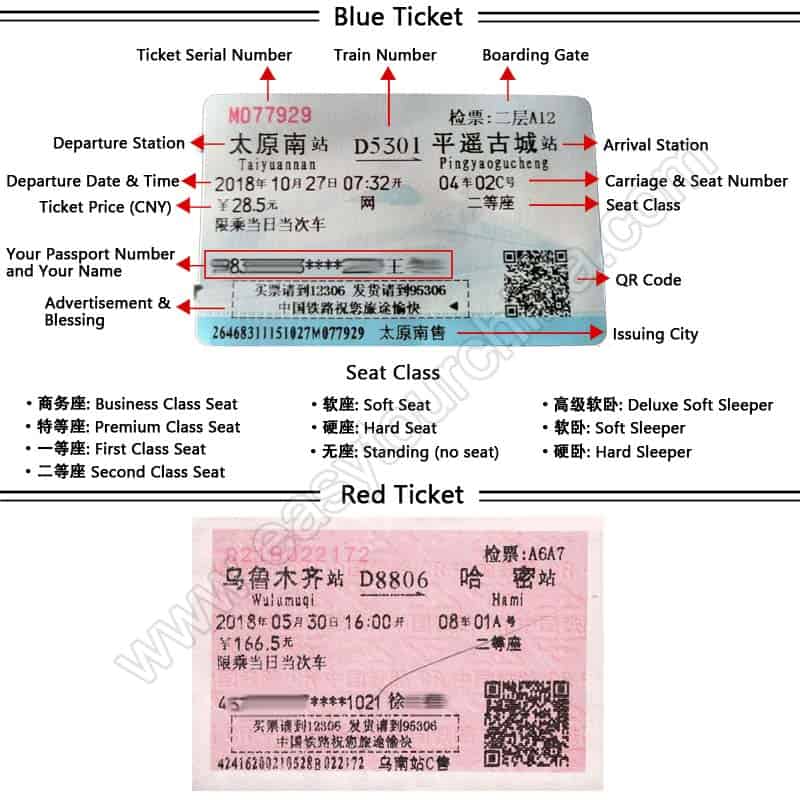How to Read China Train Tickets
There are two types of train tickets in China (no matter it’s a bullet train or normal-speed train): blue train tickets and red train tickets. The information shown on both the blue tickets and the red tickets is the same although they are different in color. The difference between the two types of China train tickets is that the blue ones are magnetic and can be read by the automatic ticket machines while the red ones can only be validated manually by train station staff when checking in.
Once you collect your tickets, you might be frustrated because some of the main information is in Chinese and pinyin and no English available. Is it possible for you to read a China train ticket? The short answer is yes. In this step-by-step tutorial, we will walk you through reading a China train ticket. Hopefully, it will make your train travel in China much easier.

Ticket Serial Number
The serial number of a Chinese train ticket is on the top left corner in red color, consisting of both letters and digits. This serial number doesn’t really matter to you for train boarding and disembarking.
Boarding Gate
The boarding gate is in the top right corner. It’s the exact place to board a train after entering the train station. Most of the train tickets in China have boarding gate information, but you should be aware that some don’t. If your train ticket doesn’t have boarding gate information, you should check the big LED screen after getting into the station. Or consult the railway staff. The following Chinese characters might help you to locate the boarding gate.
>> Related reading: How to Take a Train in China
Departure and Arrival Station
The biggest Chinese characters on the ticket are the names of departure and arrival stations, with departure station on the left and arrival station on the right. English letters under the Chinese characters are the station name in Chinese pinyin rather than in English. For instance, Beijing South is spelled as Beijing Nan.
A China train station is usually named after the city name. For example, the first main station in Beijing was named Beijing Railway Station. When new stations were built in Beijing, the stations were named according to their locations in the city. Therefore, when there is more than one railway station in a city, any station built later is named “city name + location name”. The locations used in train station names are mostly:
That's why Beijing South Railway Station is Beijing Nan in Chinese pinyin. Nan means the south direction in the Chinese language. However, A few train stations are named after famous local places such as Shanghai Hongqiao and Luoyang Longmen.
Train Number
The train number is between the departure and arrival station, consisting of an English letter and up to four digits. The English letter prefix shows what type of train it is:
>> See more information about China train types and facilities on the train
Departure Date and Time
The departure date and time are under the pinyin of the departure station name. The format is YYY-MM-DD hh: mm. Keep in mind that the time is in China Standard Time (CST), GMT/UTC+8. And there is no arrival time on the ticket. Meanings of Chinese characters showing after the digits are listed here:
Carriage Number and Seat/Berth Number
The carriage number and seat/berth number are under the pinyin of the arrival station name. The Chinese character 车 means carriage, 号 means number, 上铺means upper berth, 中铺 means Middle Berth, and 下铺 means Lower Berth.
Ticket Price
The price is under the departure date in Chinese currency Yuan (¥).
Class
Under the carriage number and seat number is the class type:
Passenger’s Personal Data
According to the real-name policy, the passenger name and passport number (ID numbers for Chinese locals) are on the ticket. But you don’t need to worry about your privacy. Some parts of the passenger information are replaced by asterisks (*).